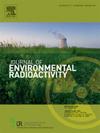Estimation of soil-to-plant transfer factor across six local government areas of Kwara state, Nigeria
IF 1.9
3区 环境科学与生态学
Q3 ENVIRONMENTAL SCIENCES
引用次数: 0
Abstract
Transfer factors (TFs) are among the necessary parameter values for the mathematical modeling of radiological pollution's environmental impact. In this study, 238U, 232Th, and 40K activity concentrations and TFs were estimated in 48 soil and plant samples through gamma-ray spectrometry NaI(Tl) in six selected areas of local governments in Kwara State, Nigeria. The findings revealed that the soil and plant samples' 238U and 232Th activity concentrations were within the radiological safety limits. The TFs of soil to plant fell within the worldwide ranges. A set of statistical tests were applied to verify the validity of the data, such as descriptive analysis, the analysis of variance (ANOVA) test, frequency distribution, and Spearman's correlation. The study reveals a skewed distribution in data. Spearman correlation coefficient analysis indicates a moderately negative correlation between 238U, 232Th, and 40K's activity concentrations and their respective TFs (TFU, TFTh, and TFK). In terms of future research in the study area, it is hoped that the data from this study will contribute to improved scientific knowledge.
估算尼日利亚夸拉州六个地方政府区域的土壤-植物转移因子。
转移因子(TFs)是放射性污染环境影响数学建模的必要参数值之一。在这项研究中,通过伽马射线光谱法 NaI(Tl),对尼日利亚夸拉州六个地方政府选定地区的 48 个土壤和植物样本中的 238U、232Th 和 40K 放射性活度浓度和转移因子进行了估算。研究结果表明,土壤和植物样本中 238U 和 232Th 的放射性活度浓度均在辐射安全限值之内。土壤和植物的放射性活度系数在世界范围内。为验证数据的有效性,采用了一系列统计检验方法,如描述性分析、方差分析(ANOVA)检验、频率分布和斯皮尔曼相关性。研究显示数据呈倾斜分布。斯皮尔曼相关系数分析表明,238U、232Th 和 40K 的活性浓度与各自的 TFs(TFU、TFTh 和 TFK)之间呈中度负相关。就研究区域的未来研究而言,希望本研究的数据将有助于增进科学知识。
本文章由计算机程序翻译,如有差异,请以英文原文为准。
求助全文
约1分钟内获得全文
求助全文
来源期刊

Journal of environmental radioactivity
环境科学-环境科学
CiteScore
4.70
自引率
13.00%
发文量
209
审稿时长
73 days
期刊介绍:
The Journal of Environmental Radioactivity provides a coherent international forum for publication of original research or review papers on any aspect of the occurrence of radioactivity in natural systems.
Relevant subject areas range from applications of environmental radionuclides as mechanistic or timescale tracers of natural processes to assessments of the radioecological or radiological effects of ambient radioactivity. Papers deal with naturally occurring nuclides or with those created and released by man through nuclear weapons manufacture and testing, energy production, fuel-cycle technology, etc. Reports on radioactivity in the oceans, sediments, rivers, lakes, groundwaters, soils, atmosphere and all divisions of the biosphere are welcomed, but these should not simply be of a monitoring nature unless the data are particularly innovative.
 求助内容:
求助内容: 应助结果提醒方式:
应助结果提醒方式:


